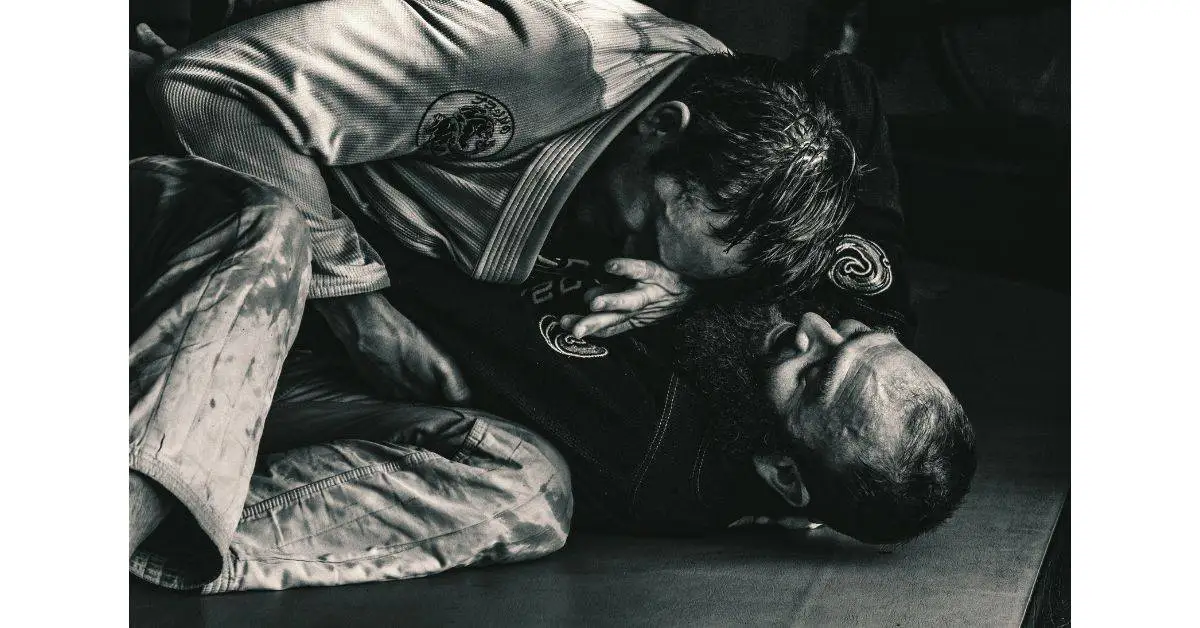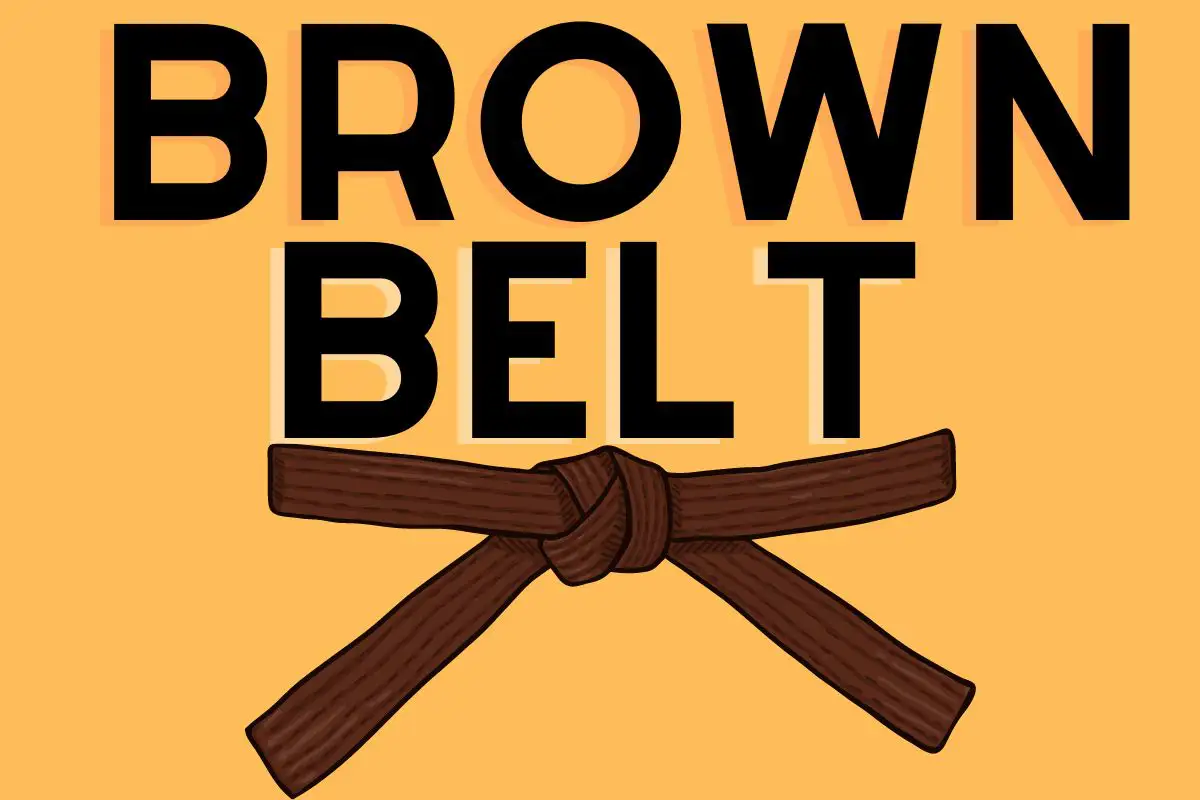The difference between a BJJ brown and black belt is smaller than that between a brown and a purple belt. So, what does that mean? Once you’re a brown belt, you’re closer to being a black belt than a purple belt. Or, in simpler terms, you’re a dangerous, competent fighter.
A black belt is a competent grappler that knows how to use all types of submissions, including leg submissions (toe hold, kneebar…) He also has mastered the basic submissions from all positions, including full mount, closed and open guard, and side control. As a result, he’s an overall dangerous fighter.
If you take a typical BJJ gym and have everyone take their belts off, you might get confused between brown and black belts. Both are more than competent in submitting the belts below them.
On the other hand, you might see a specific phenomenon if you examine purple belts. Many of them might still lose once in a while to blue belts. But, on the other hand, it’s more than likely that brown belts will dominate their purple belt partners.
Indeed, the difference is vast.
In this article, I’ll examine the characteristics of a brown belt and what that means to be one. Likewise, I’ll highlight the primary techniques you want to focus on if you’re in this belt color. So, without further ado, let’s dive in.
Characteristics of a BJJ brown belt
The first part of this article will examine the characteristics of a BJJ brown belt. However, before we dive in, let’s see what this article will review and examine:
- Characteristics
- Tips to progress faster
- What to focus on
- Q&A
So, staying tuned for the entire article will be worth it. Also, I want to mention that you want to read each section because I’m always including ninja tips and common mistakes that many grapplers make—while offering you practical solutions to these mistakes.
Enough intro; let’s dive in.
A brown belt is a fantastic fighter
You first want to know that brown belts are excellent fighters. They can beat the average person in a street fight and in a self-defense situation.
BJJ is an insanely effective martial art. You’ll be able to use what you learned in the Jiu-Jitsu gym to finish off your real-life opponents quicker than you might think.

Brown belts know how to maneuver themselves according to their opponents. This is an efficient skill to have because it’ll help you get into dominant positions.
If you want to learn about BJJ’s most effective and dominant positions, such as the closed guard, follow this link.
A BJJ brown belt has mastered the basics
Unlike the purple belt, who is still developing his style, a brown belt has already mastered the basics and knows how to use them efficiently.
Likewise, he’s way closer to being a black than a purple belt. As a result, it’s more likely that he’ll beat a black belt than lose to a purple. Hopefully, you’ve understood where I’m going with this.
Brown belts must stay in their rank for an entire year before advancing. However, it might take more than that, obviously.
Back to our topic, brown belts have mastered the basic submissions and positions. They know how to pass the opponent’s guard swiftly and how to finish from the dominant positions, such as side control.
A BJJ brown belt has developed his style
We’ve already reviewed this, but I think it deserves its own section.
Until the brown belt, you develop a unique grappling style. For instance, when you’re a BJJ white belt, you’re learning the basics, grasping the purpose of this martial art, and learning the most basic techniques.
Next up, blue belts learn to combine techniques and start to understand how everything falls into place. The blue belt is when you’ll see most of your progression. You’ll suddenly become a capable fighter out of nowhere.
Then, you’ll develop your unique BJJ style in the purple belt. So, you’ll start to work on things you find suitable for your style. That’s when Brazilian Jiu-Jitsu becomes the most fun. Other grapplers will begin to learn how you act and react to different attacks. Really, it’s like chess.
Now that you’re a brown belt: you have already developed your style. What’s left is to hone it while perfecting other techniques. And, of course, you always want to keep learning and broadening your knowledge base.
The competitive scene of brown belts is fierce
Let’s examine the competitive scene of this magnificent belt color. As you already know, brown belts are more than competent fighters. They’re capable of submitting an opponent with ease and do so fast.
The competitive scene is brutal in this belt color. What’s different is that more people will begin using leg locks, such as the toe hold and kneebar.
At the end of the day, it’s when your opponent becomes extremely capable. They begin to think more, and you’ll start seeing more trainees use techniques you never thought of.
Although the thumbnail reveals the winner, I encourage you to watch this fight and understand these fighters’ capabilities. If they take their belts off, you wouldn’t have been able to point out which belt color they are. I think the case is different with purple belts.
A brown belt is mentally tough
All BJJ trainees are mentally tough. They’ve sparred countless times and know how it feels when their opponent submits them. They know what real pain feels like.
But, a brown belt is when the trainees get really tough. But, of course, your mental toughness depends on how often and how much you spar. And still, this is when trainees get accustomed to pain at a level that they don’t care as much about it.
They’re also more consistent in all areas of life, as BJJ teaches us that you want to dedicate yourself to the things that will bring the most value to your life. It’ll be worth it not to spend your time on useless activities. Instead, you want to focus on the things that bring value while applying 100% of your effort to them.
This is what real mental toughness is about, and you’ll see that often in brown belts.
Tips to progress faster from BJJ brown to black belt
Alright, let’s go over some tips you want to implement to progress faster from the brown to the black belt. This section will be more mindset-oriented.
I’m a big believer in focusing on your mindset and mental toughness as much as on your actual BJJ skills. So do that, and you’ll stay consistent and dedicated to your training throughout your entire journey.
You must be a brown belt for at least one year before advancing to the black belt (IBJJF rules.) Then, you’ll need to pass an exam to test your skill in different areas, such as passing guards, escaping mount and side control, and sparring. You’ll attain the black belt once you pass them all.
Alright, without further ado, here are some tips you want to implement in your BJJ journey to gain more results and attain the black belt faster.
#1 – Set small milestones
The first tip will be to set small milestones. Many grapplers will struggle to stay consistent because their goals are too long-term. They’re looking too far ahead in the future, so attending the next training session becomes a burden.
We want to avoid that by setting small milestones. What can those be? You might ask. Here are a few examples:
- Learning a new technique
- Winning a spar
- Mastering a position
- Attaining the next belt
- Attaining the next stripe
Do that, and you’ll want to attend the next training session. After that, staying consistent won’t become a problem.
There’s a known phenomenon that happens to humans: it’s called the halfway consistency problem. We tend to give up after the halfway point. That’s why many BJJ practitioners give up their progress after the blue belt. If you want to learn more about this interesting phenomenon, follow this link.
#2 – Find your purpose if you haven’t already
The second tip will be to find your purpose from training. Now you’ve been training for quite a while (at least 3 years!) That’s a lot. You likely know what the driving force behind your consistency is. But if you don’t or – don’t have as much motivation anymore, it’s time to do something about it.
Most BJJ trainees who quit – do so because they have no purpose. They’re training either as a hobby or without any goals. How can you expect to stay consistent under such conditions?
Your purpose can be anything: from learning to fight to better yourself so you can better the world.
I always find that when my purpose is egotistical, I quit. But, when my purpose has an outside meaning, it’ll be more potent than ever. And as a result, I’ll want to learn and progress more.
#3 – Focus on your weak points
This tip will be more practical than the others. So here it goes.
You want to focus on your weak points as much, if not more, than on your strong points. For example, let’s say your open guard isn’t solid; well, do something about it. Start learning from all the coaches with the knowledge you’re looking for – and start implementing. It’s as simple as that.
What you’ll find happening if you follow that—is that your open guard suddenly becomes much better. You’ll want to use it more often, and it’ll become your strong point.
Repeat that process long enough, and your grappling skills will skyrocket. This, by the way, applies to any area in life. If you want to make more money, see what your weak points are in your workplace and start honing these. You’ll be a leading candidate for a promotion soon enough!
Oh, and if you want to master the open guard position, follow this link. 🙂
#4 – Remain as consistent and dedicated to your training
The last tip is more obvious, but it’s worth mentioning, as you want to keep that in mind when you’re a brown belt, especially in this position.
Remaining as consistent and dedicated to your training as a brown belt as when you were a white belt will be difficult. So you might have to find another purpose that’ll keep you as motivated.
If you can remain as consistent and dedicated to your training as when you first started, the sky’s the limit.
Your progression rate will be insane. But you’ll regain your true love for the sport of BJJ and make it your lifestyle. This is how true masters are born. You can become one of these masters if you make it your lifestyle.
Indeed, all the tips connect.
So, in short, remain as consistent and dedicated to your training in your current position as when you first started. Do that—and the sky’s the limit for your BJJ journey.
What to focus on as a BJJ brown belt
This section will be more practical than all the other ones. I’ve found these things to be the most helpful and help more trainees progress faster when they specifically focus on these.
That’s why I’ve decided to write this section, so you can focus on the right things and, thus, see more results from your training.
You’ll see more results from your training and be more motivated to remain consistent and dedicated.
Being more consistent and dedicated in your training will lead to more results, a cycle you want to be a part of.
And more results will lead to a better progression rate and more motivation.
Alright, I hope you understood my point; let’s dive into the 3 primary things you should focus on as a Brazilian Jiu-Jitsu brown belt.
#1 – Leg Locks
Using leg locks is illegal until you’re a brown belt in BJJ. So you won’t learn these, but you’ll spar against trainees who already learned them, so they’ll use it on you.
Thus, you’ll understand some of the basics of how to defend against such attacks. Therefore, I won’t go over the defense against such attacks. Instead, we’ll focus on the offensive side of things.
Learning leg locks will be the most attractive thing you’ll have as a brown belt. You’ll suddenly be open to learning new techniques – which might make some BJJ trainees overwhelmed. However, you still want to learn a few leg attack submissions to be more threatening to your opponents.
Leg locks are the first thing you must focus on as a brown belt. Here’s a brief explanation of the fundamentals.
#2 – Honing your unique style
When you’re a white belt, you’re learning the basics. Next, you’re learning to combine different techniques when you’re a blue belt. Then, you attain the purple belt and develop your unique grappling style. Now, what’s up next in the brown belt?
You want to hone your unique BJJ style when you’re a brown belt. You already know the basic submissions and dominant positions and how to use them; you have a unique style only you use.
The one thing left in the equation is to keep honing your unique style. You have your favorite submissions and positions. What you want to do now is keep mastering these.
Avoid mastering techniques that you dislike. Instead, it’ll be worth it to focus on a few specific techniques and positions you fancy most and master these only. Your grappling skills will improve quickly if you do that.
#3 – Staying consistent and dedicated
Believe it or not, many BJJ brown belts end up quitting. You might be familiar with the blue belt curse, as most trainees will quit when they’re blue belts (for reasons we’ve gone over.)
And still, if you start to become complacent in your training, you’ll soon be out of the equation. So please keep aiming high; set high standards and have high ambitions.
You want to keep improving, even in your current respectable position. Other trainees will set their goals on you; they’ll try and surpass you. Therefore, you must keep improving if you ever want to attain the honorable black belt.
So, stay consistent and dedicated to your training. You can read the previous section, where I listed some of the most beneficial tips people in your current position found helpful. These will help you stay more consistent.

Are brown belts in BJJ good fighters?
Brown belts in BJJ are competent fighters capable of controlling their opponents and maneuvering them to a position where they can submit them easily. They also control the dominant position, such as full mount, side control, and open and closed guards—while transitioning between them all.
BJJ brown belts can beat the average person in just a few seconds.
What does a BJJ brown belt know?
A BJJ brown belt knows the basic and advanced submissions, such as Kimura, Americana, and many leg locks. One also knows the dominant, effective positions, such as side control, full mount, and turtle position. However, the most effective thing one knows is to combine these positions and submissions in a unique style.
How high is a brown belt in BJJ?
The BJJ brown belt is the 4th belt, the 5th being the black belt (the highest one). Attaining the black belt will likely take more than 5 years of dedicated training, so less than 5% of all BJJ trainees will ever reach such a position. Nevertheless, being in such a rank in such a difficult martial art is highly honorable.
Are brown belts dangerous?
BJJ brown belts are dangerous fighters who know how to maneuver their opponents according to their goals. They’ll also be capable of reading the opponent and understanding his weak points to attack him from the position he’s least capable of defending. That’s what makes brown belts exceptionally dangerous.
Can a BJJ brown belt teach?
Brown belts in BJJ are allowed to teach, as they’re unfamiliar with a few specific techniques. They’ve also had prior experience using the techniques they learned in real fights so that they can teach from experience—the most effective way of teaching.
Final words
I’ve had a blast writing this article, as I’m familiar with people’s shared beliefs about brown belts. I also know how BJJ brown belts feel when they’re in their current position.
It can be complicated to remain enthusiastic about this martial art when you’re that advanced. It might become boring to attend training, so you’ll want to avoid that.
However, you can light that inner fire once again by implementing the tips I listed in this article, as they’ve helped others before you. You also want to remain as ambitious as when you first started; that’ll help you achieve remarkable goals, not just in Brazilian Jiu-Jitsu.
Hopefully, you’ve been able to take a thing or two from this article – and here are other articles you’ll definitely enjoy reading:
BJJ’s Belt Ranking System – A Comprehensive Guide
Mastering the Triangle Choke – Everything You Need to Know
Guillotine Choke 101 – How to Master
BJJ White Belts – How to Progress Faster (Guide)
You’re a BJJ Black Belt – Now What?




